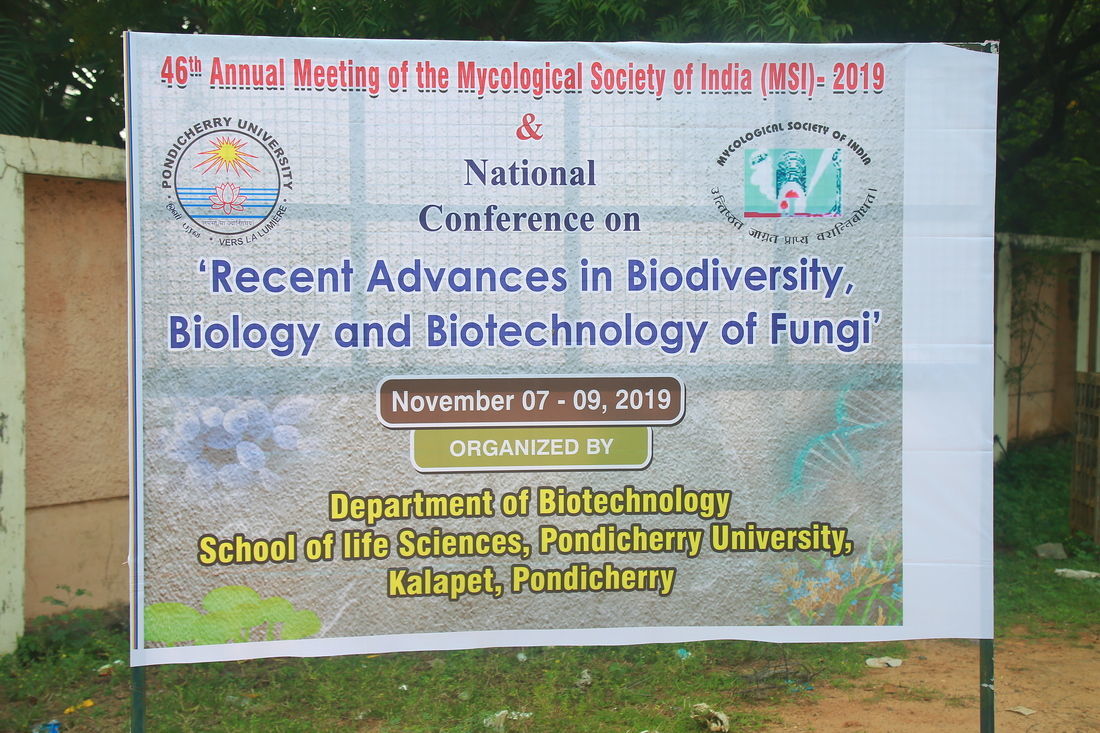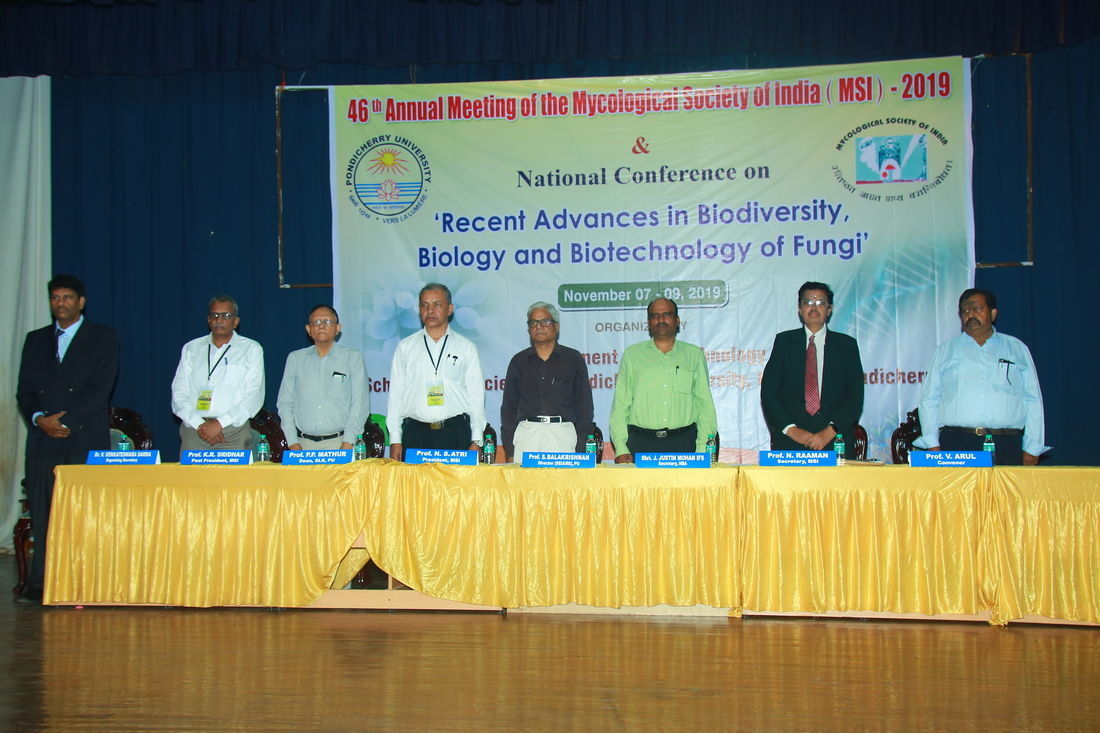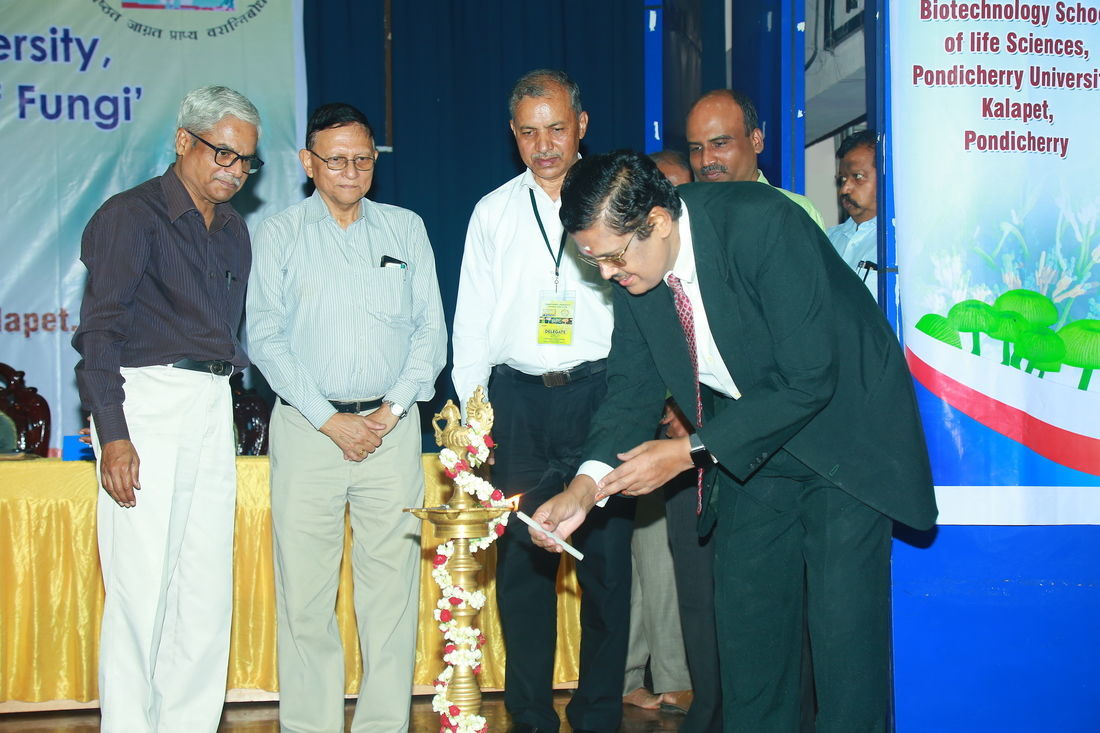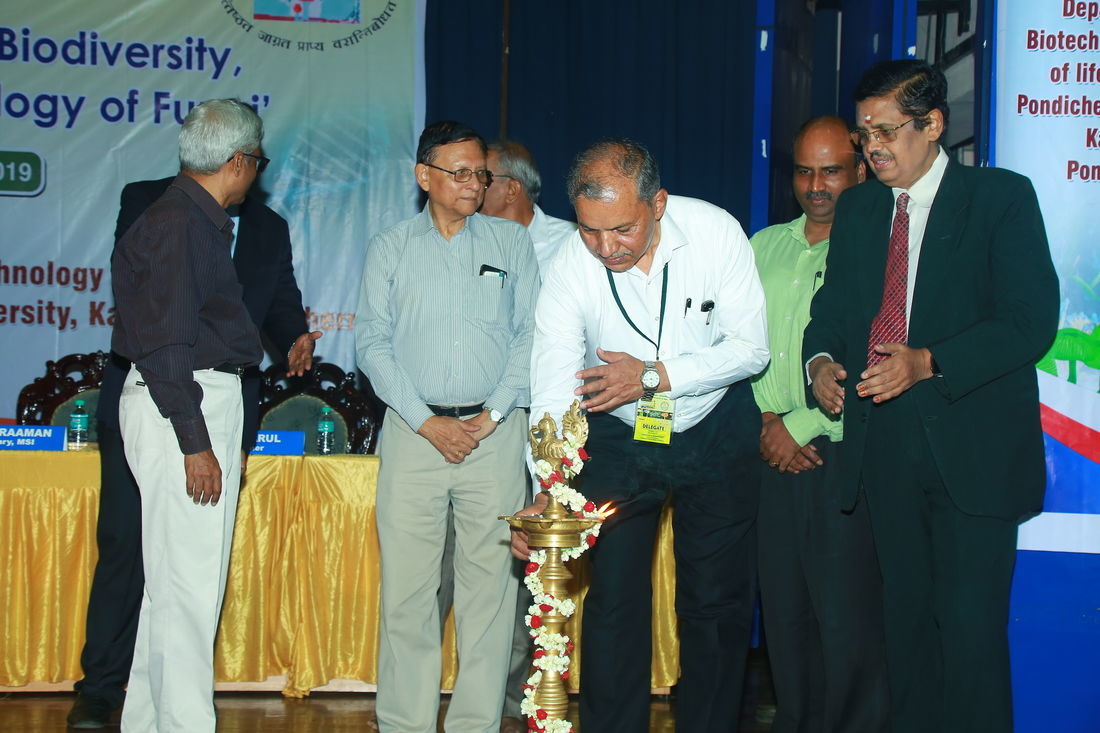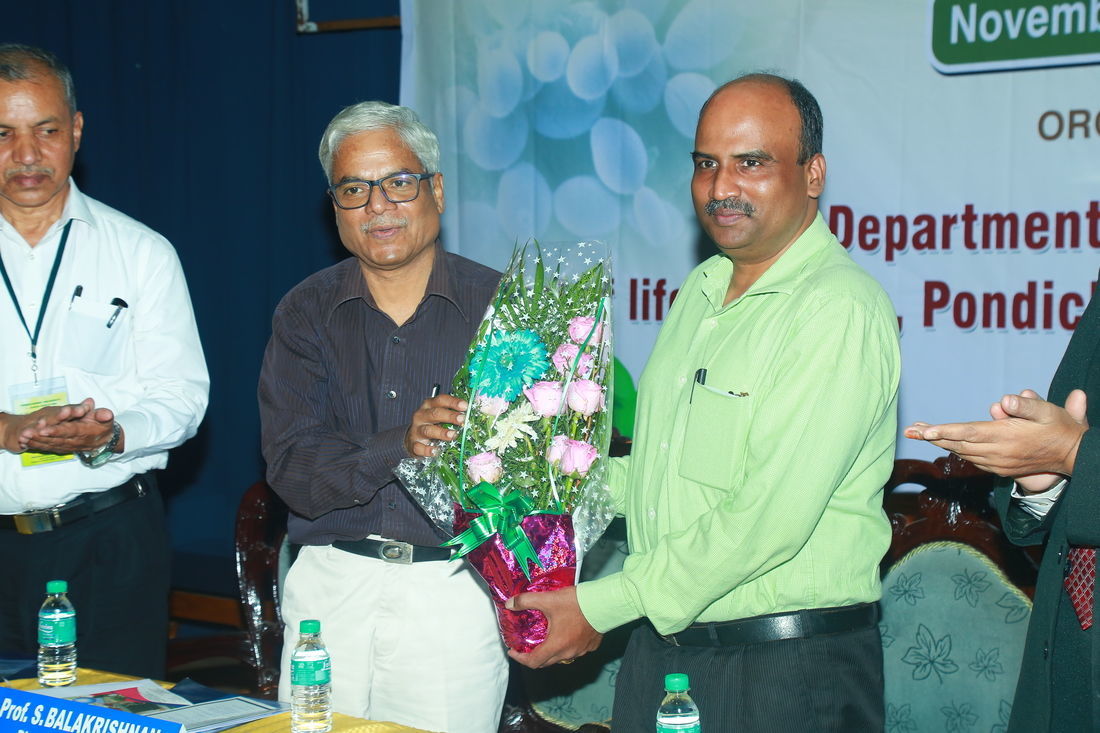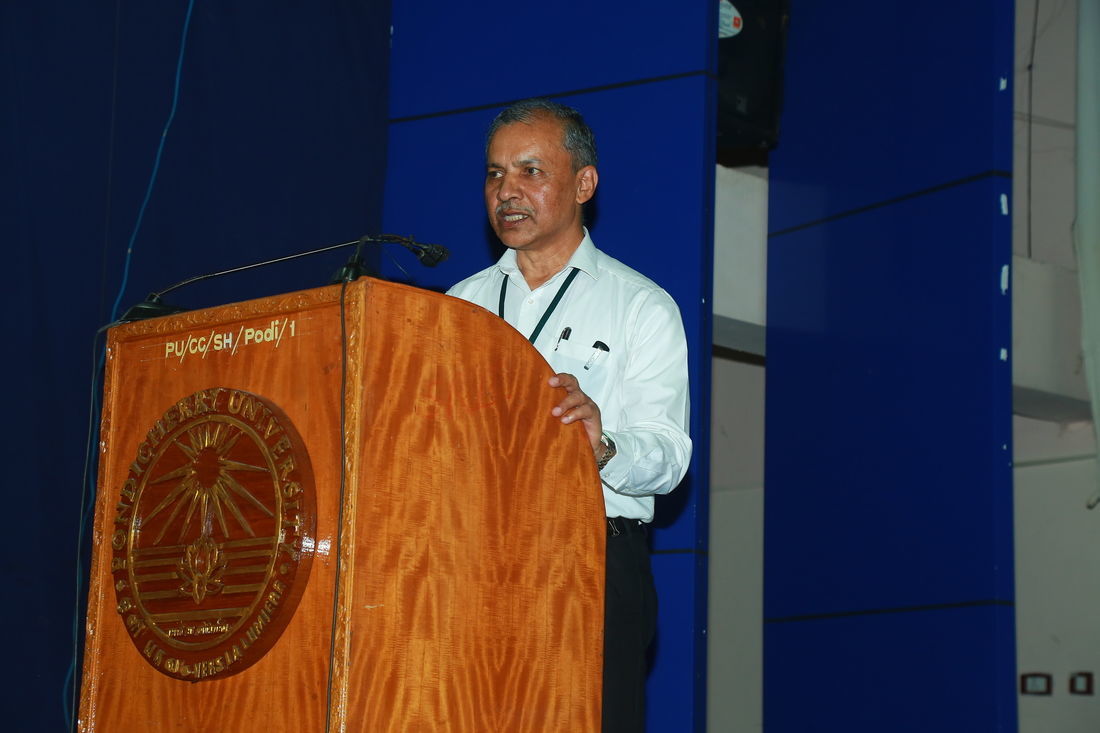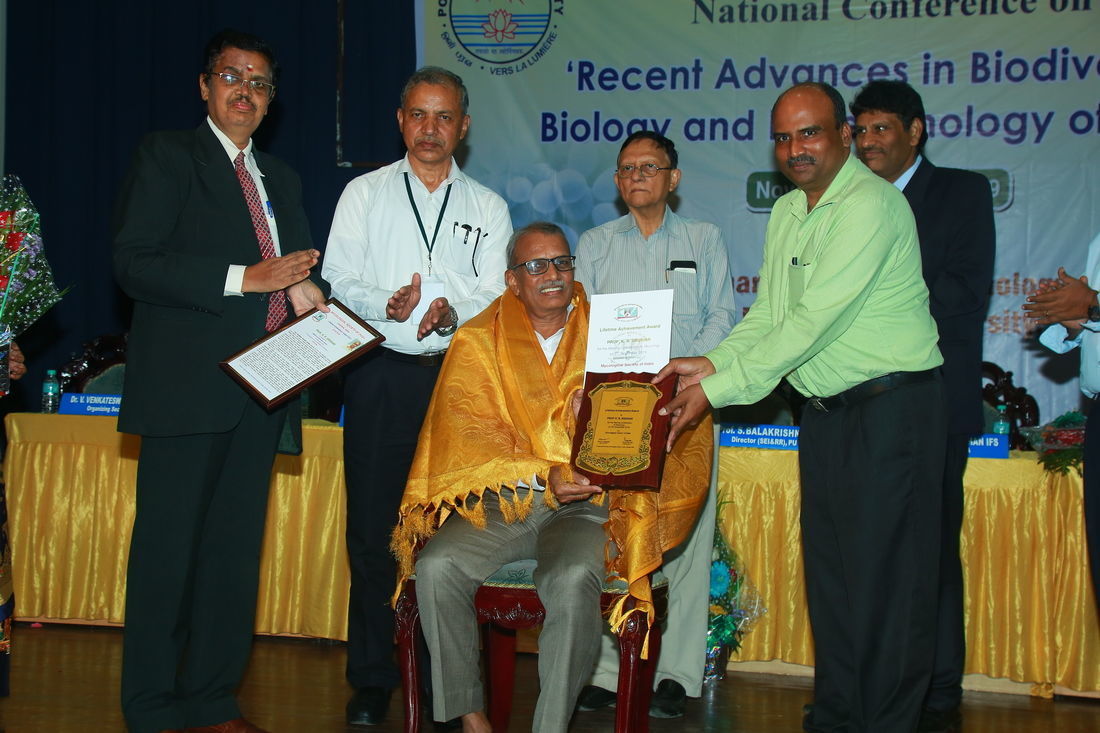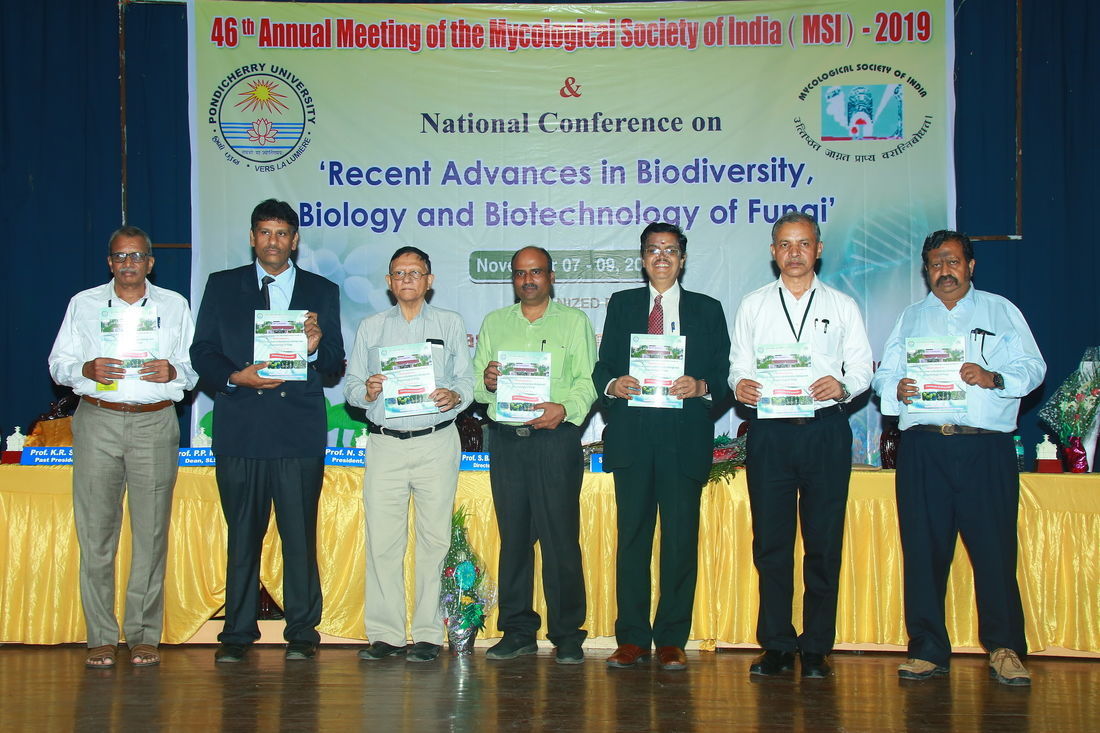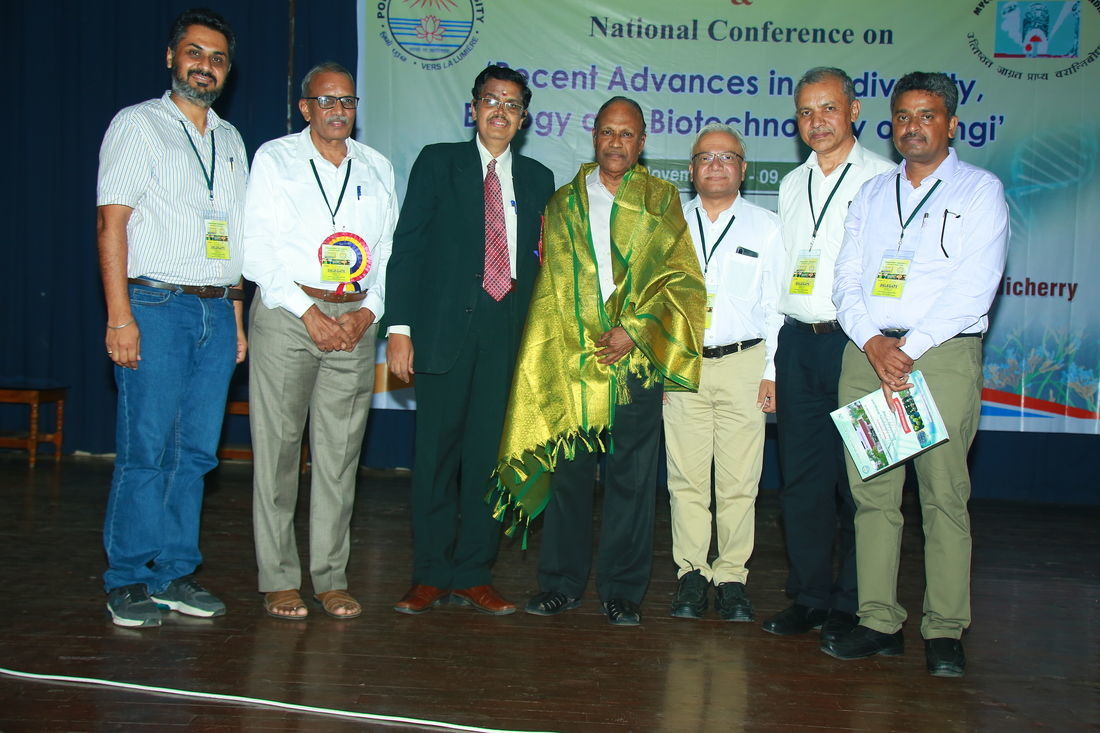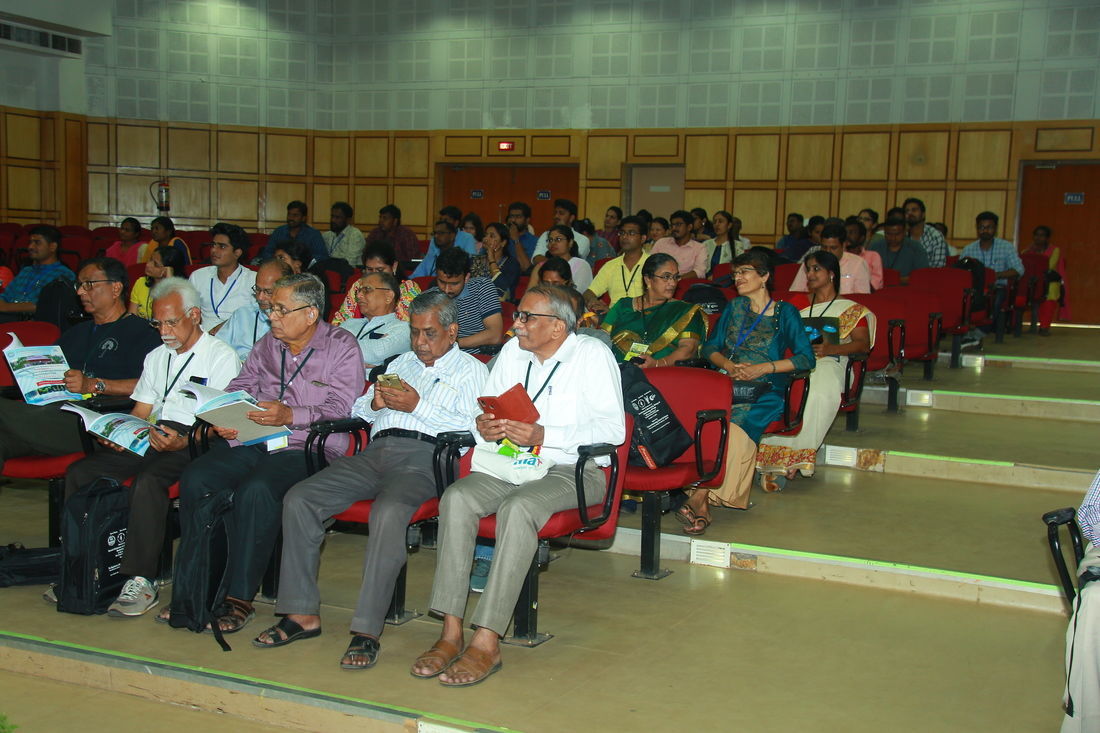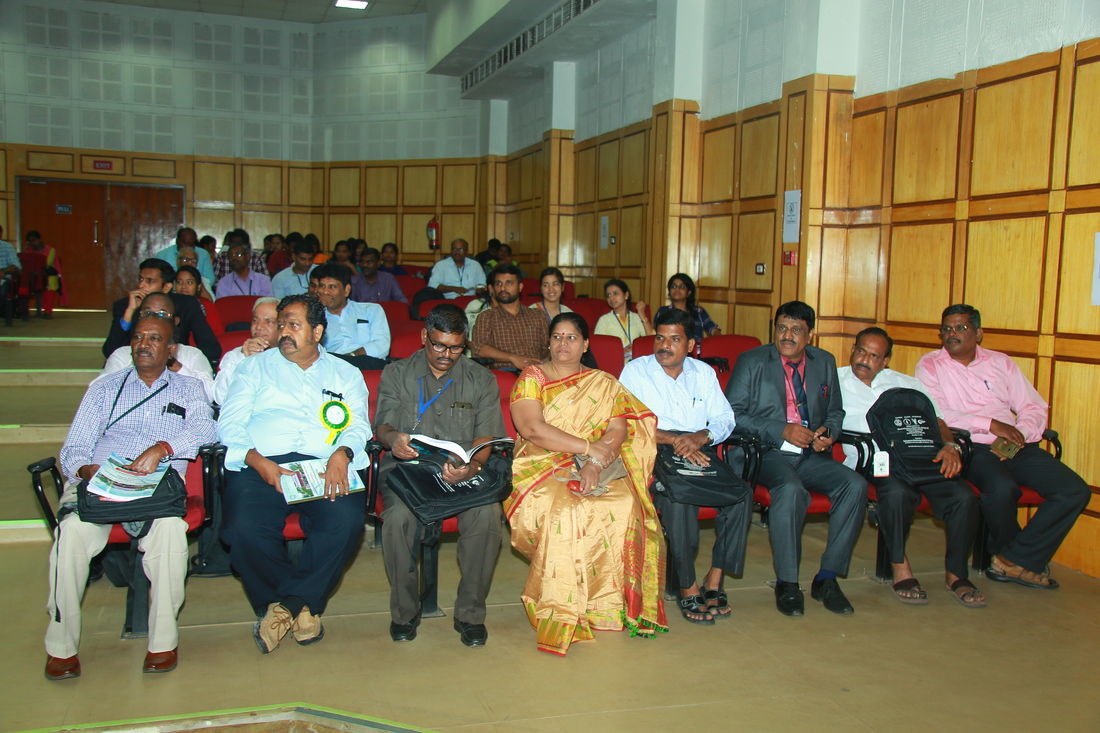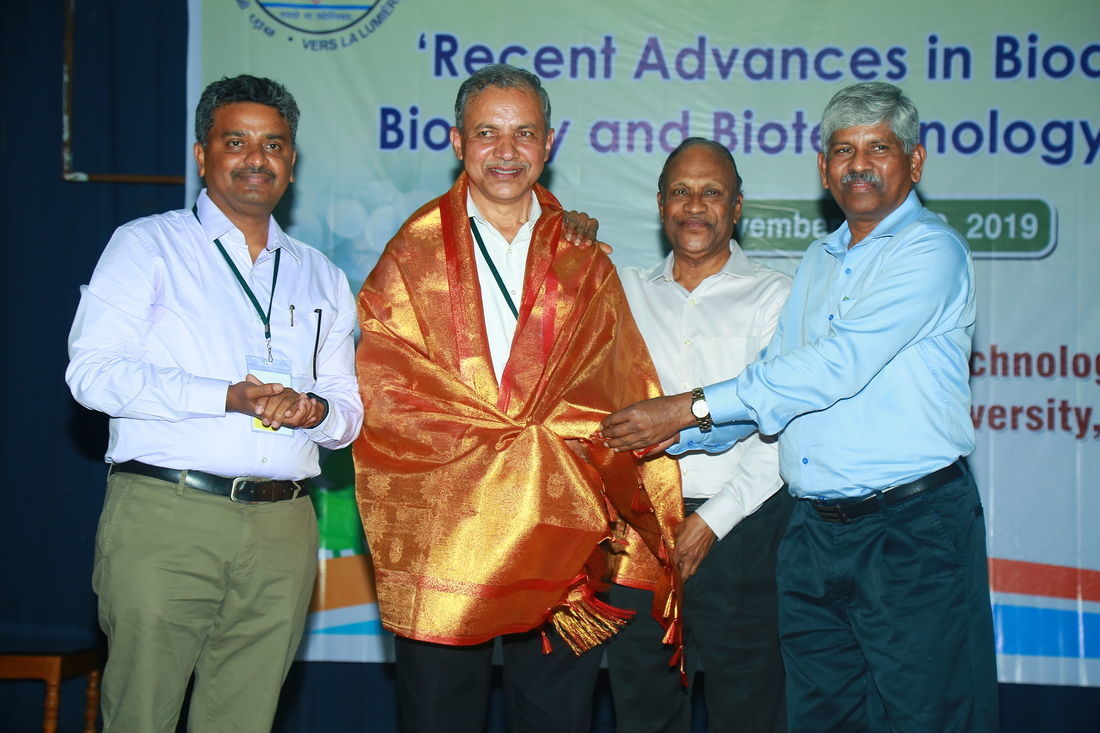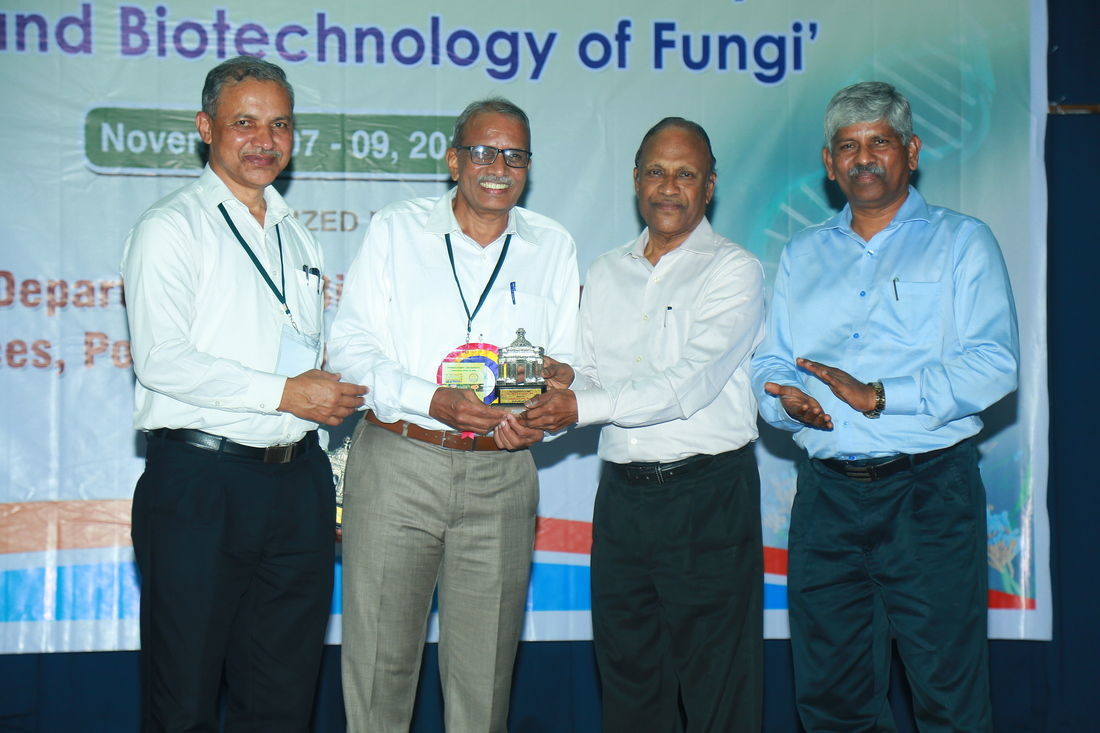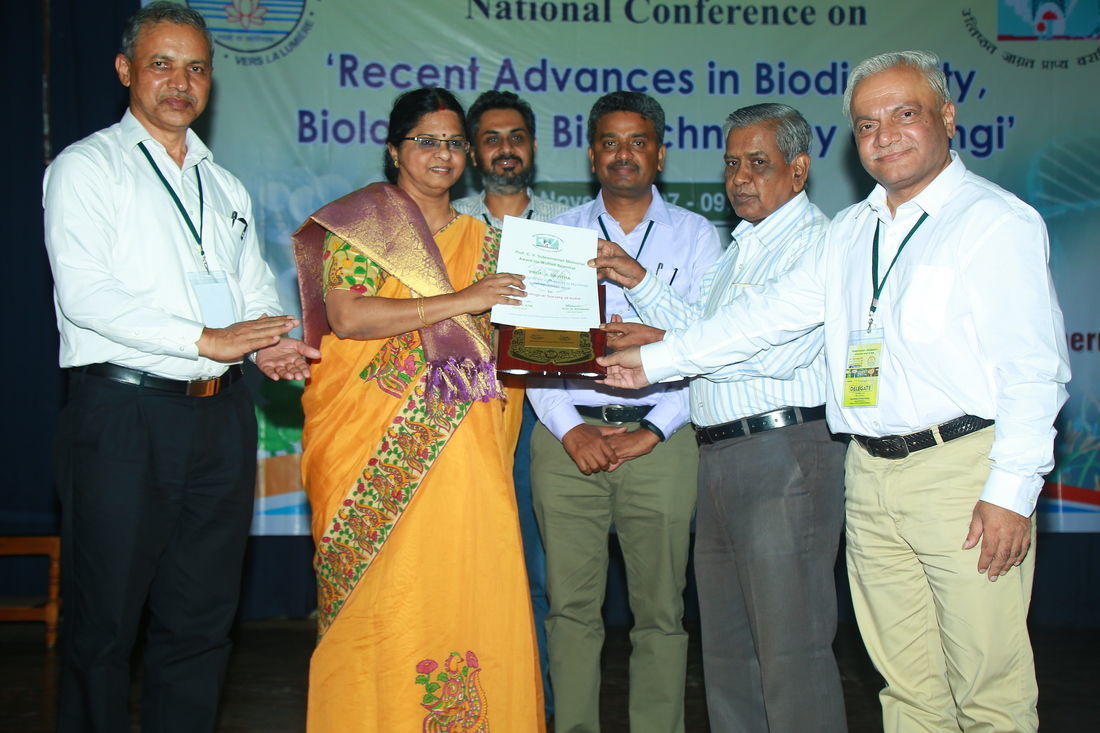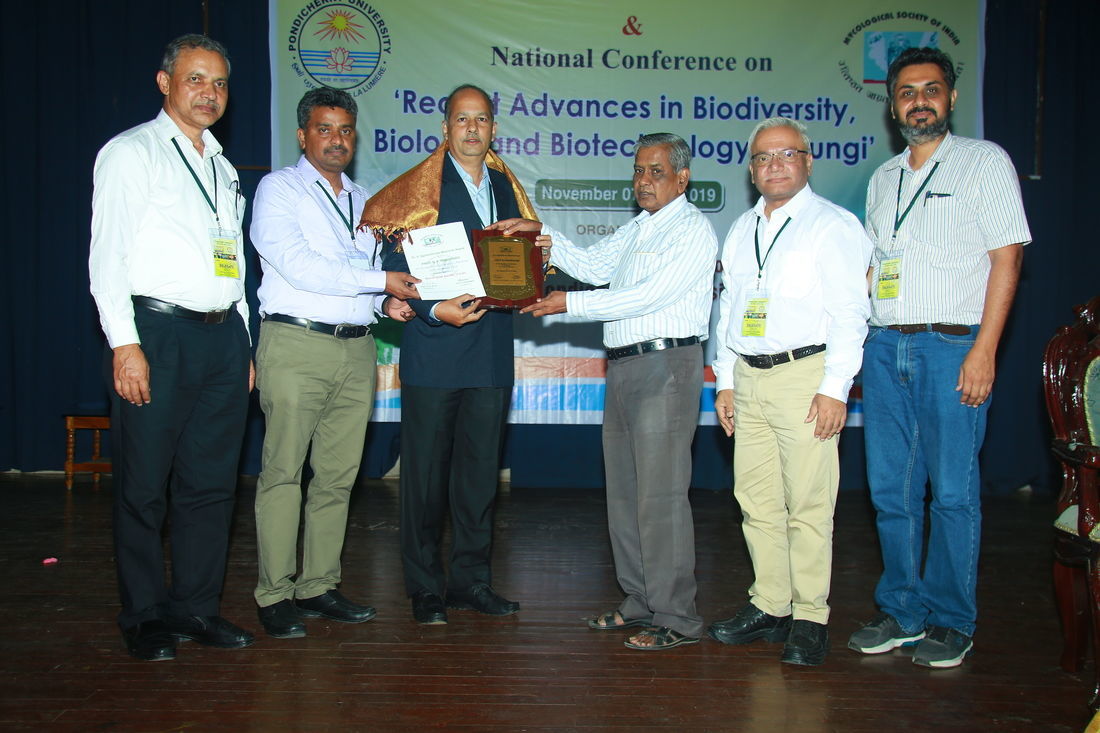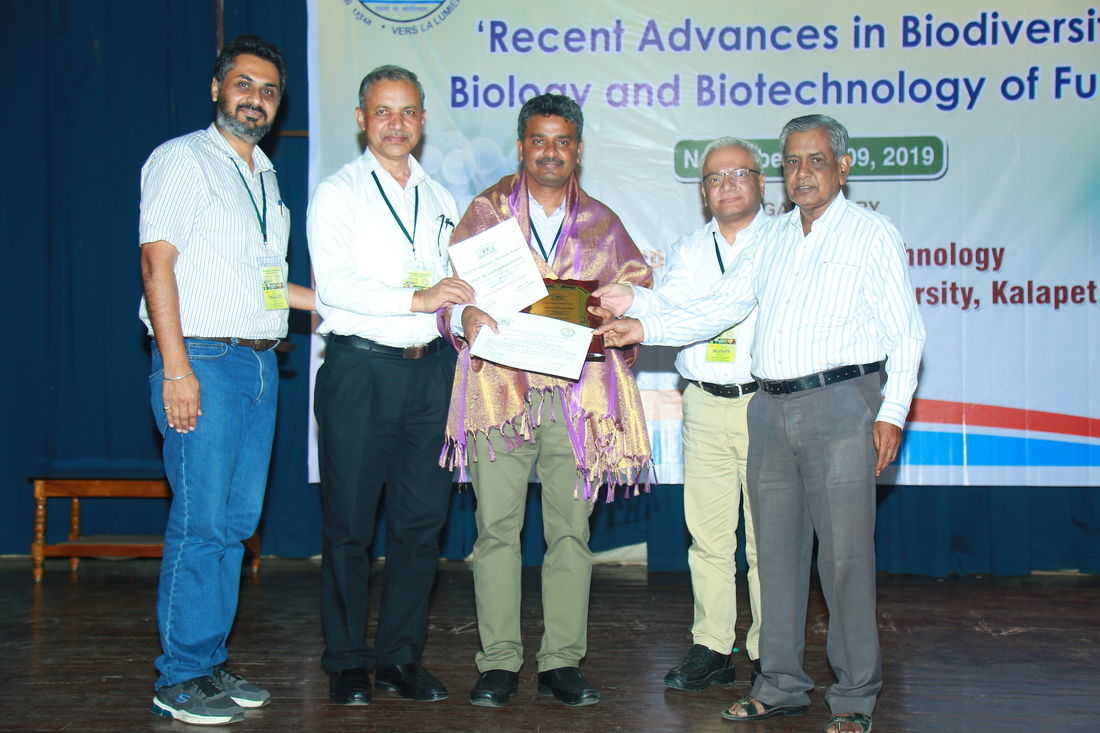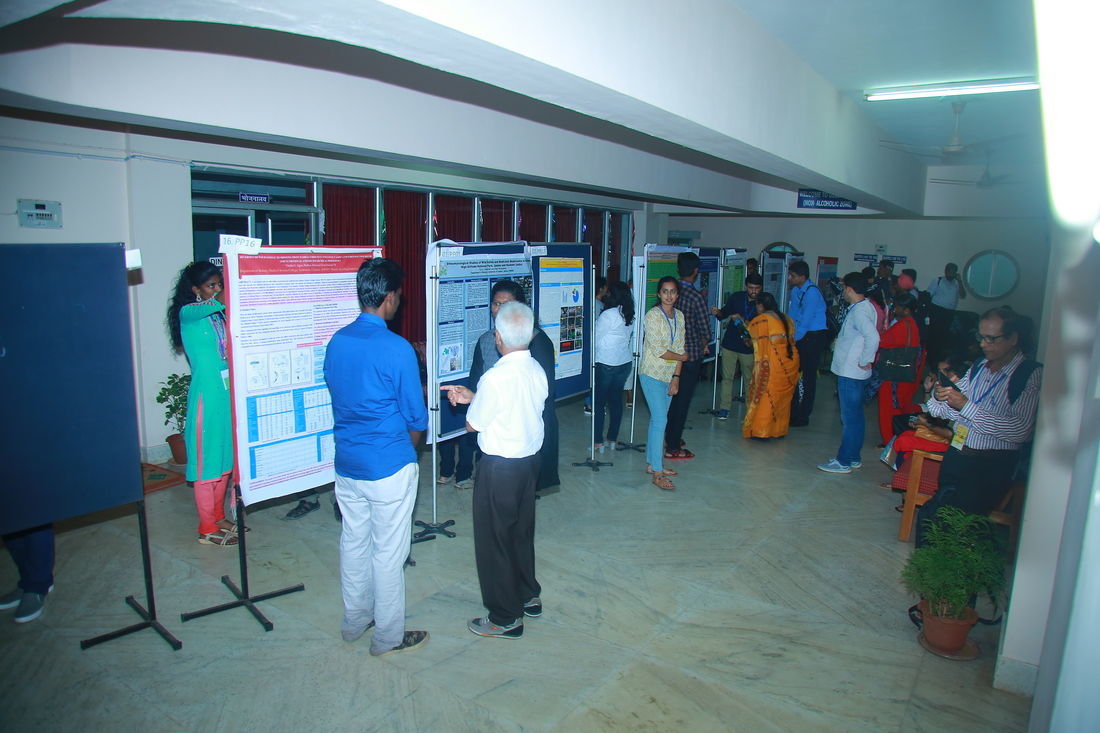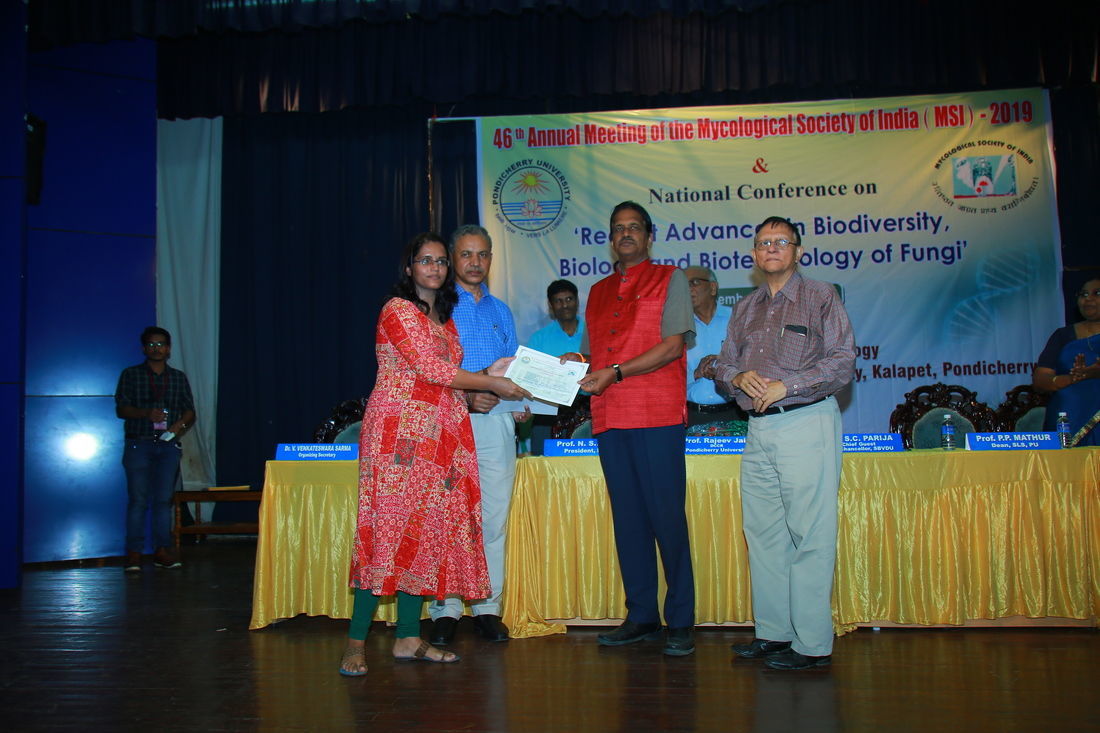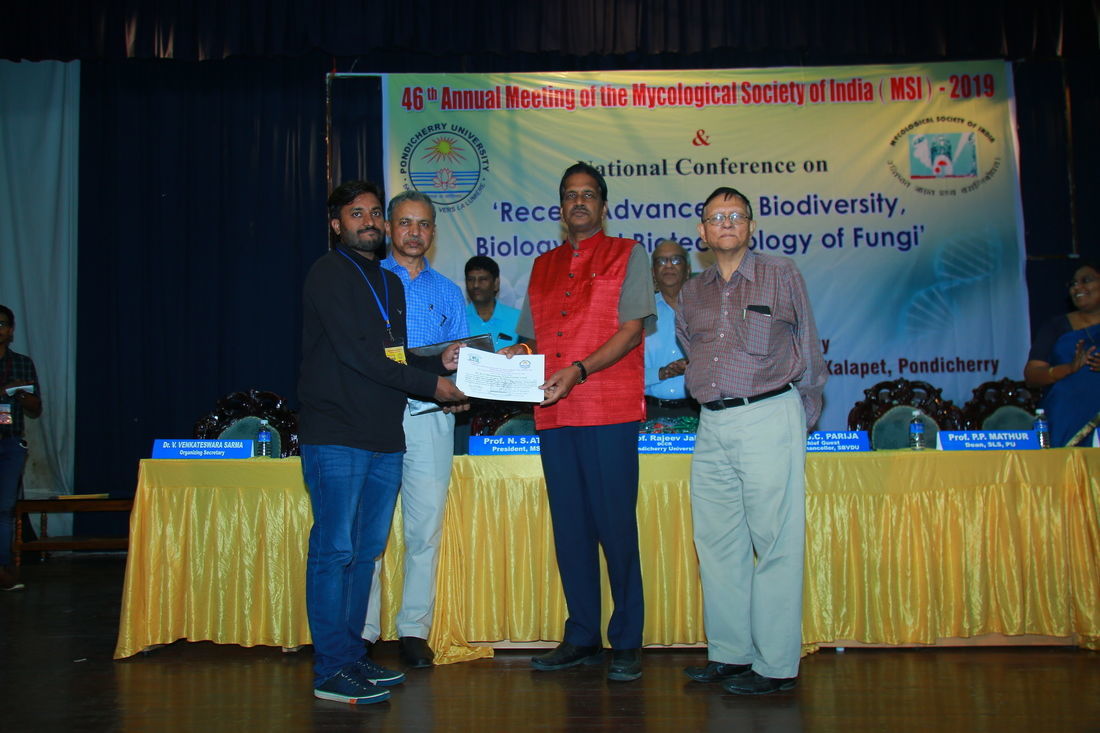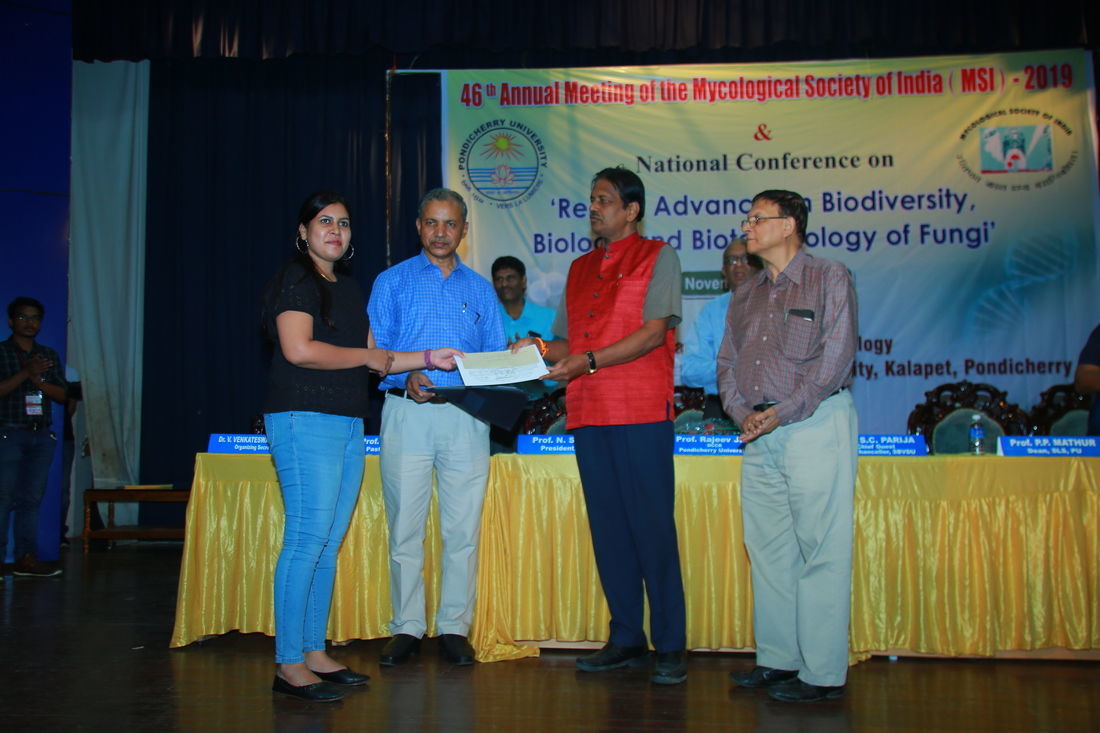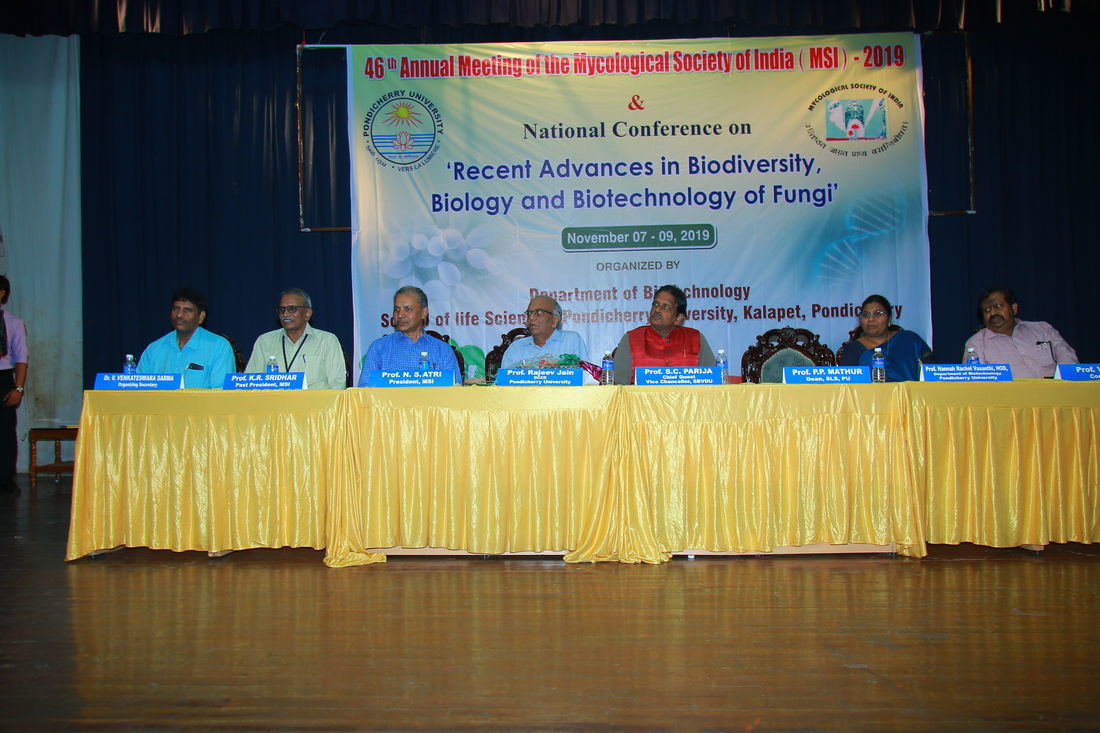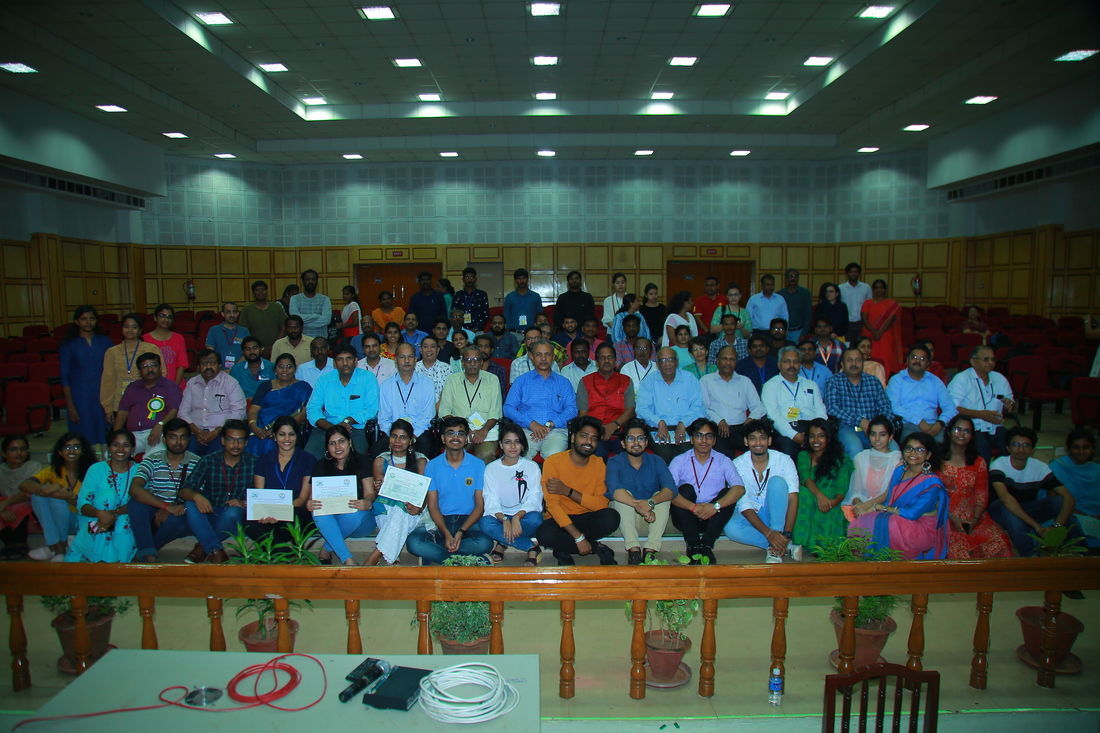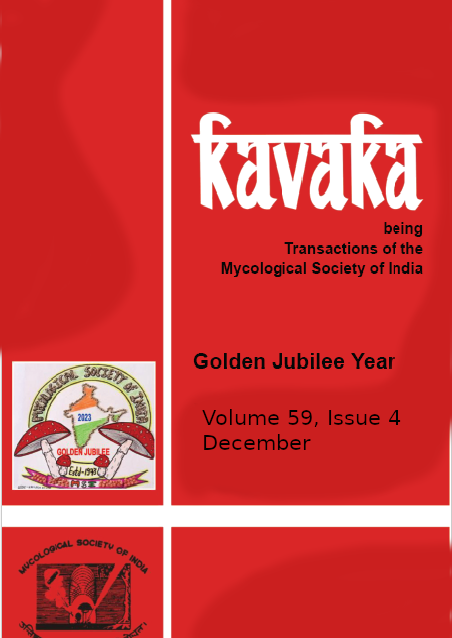Expedition with micro- and macro-fungi: New perspectives to bridge the gaps*
K.R. Sridhar
Department of Biosciences, Mangalore University, Mangalagangotri, Mangalore 574 199, India
Corresponding author Email: This email address is being protected from spambots. You need JavaScript enabled to view it.
ABSTRACT
Fungi are the most fascinating group of organisms distributed widely in different ecosystems. Strategic geographic location of the Indian subcontinent is a major hub of fungal resources which offers ample scope for their exploration as well as application. My curiosity in mycology initiated journeying freshwater lotic habitats of the Western Ghats and west coast of India. It was soon ascertained that the freshwater hyphomycetes serve as model group facilitating assessment of basic concepts of detritus food chain and aquatic productivity. Second fascinating group attracted my attention was the marine fungi in various ecosystems of the west coast playing significant role in nutrient turnover. Third striking aspect of my interest was macrofungi of the Western Ghats and west coast. The basic function and ecosystem services of all these groups is breakdown and transformation of organic matter. The impacts of decomposition is highly valuable in production of precious metabolites, enrichment of organic matter and pull other groups of organisms to drive the energy flow initiated from detritus ecosystem. All these research areas are highly fascinating in the Indian subcontinent owing to diverse habitats, varied environment, wide range of substrates and numerous fungi. Progress towards basic or applied facets of fungal diversity, significance of metabolites and sustainable ecosystem functions demands collaborative endeavors. Specific strategies and schemes for prospective harness of fungal ecosystem services in the Indian subcontinent have been discussed in this commentary.
KEYWORDS: Aquatic fungi, diversity, decomposition, detritus food web, ecoregions, Indian Subcontinent, macrofungi, mangrove fungi, marine fungi, west coast, Western Ghats
![]()
Taxonomy of Arbuscular Mycorrhizal Fungi
D. J. Bagyaraj and R. Ashwin
Centre for Natural Biological Resources and Community Development, 41 RBI Colony, Anand Nagar, Bangalore- 560024 Corresponding author Email: This email address is being protected from spambots. You need JavaScript enabled to view it.
(Submitted on February 2, 2019; Accepted on April 20, 2019)
Retraction Note to: Taxonomy of Arbuscular Mycorrhizal Fungi KAVAKA (2019) 52: 20-25
The Editor-in-Chief has retracted the above mentioned article in view of the similarity of the contents with “A history of the taxonomy and systematics of arbuscular mycorrhizal fungi belonging to the phylum Glomeromycota” published in Mycorrhiza 22:247-258 in 2012. In view of the textural overlap the corresponding author has also given his consent for the retraction of above mentioned research article.
![]()
Fungi in cold deep seas: a hot topic*
Chandralata Raghukumar
313, “Tamra” Vainguinim Valley, Dona Paula, Goa 403 004
Corresponding author Email: This email address is being protected from spambots. You need JavaScript enabled to view it.
(Submitted on April 05, 2019; Accepted on June 12, 2019)
ABSTRACT
Deep-sea is characterised by low temperatures, elevated hydrostatic pressures, low nutrients, total darkness and constant salinity. Presently numerous workers are engaged in this topic resulting in several publications, newer insights and contributions to biodiversity and understanding the physiology of deep-sea fungi. We used several techniques to isolate and culture fungi from deep sea sediments collected at ~5000 m water depth in the Central Indian Basin (CIB). These were identified by conventional, morphological taxonomy as well as by molecular taxonomy. Fungi were also directly detected in formalin-preserved deep-sea sediments. We also studied culture-independent fungal diversity at several locations in the CIB. Several environmental gene libraries were constructed after amplifying the sediment DNA using universal and fungal-specific internal transcribed spacers (ITS) and universal 18S rDNA primer pairs. This approach resulted in the recovery of several fungal operational taxonomic units (OTUs). A few culturable-phylotypes and several fungal OTUs demonstrated high divergence from the existing sequences in the GenBank. Several of them were new reports for deep-sea sediments indicating hidden treasure of fungal diversity.Physiological characterization of the cultured fungi revealed that most of the fungi were mesophiles, psychrotolerants and barotolerant. Several of them produced cold-active enzymes having tolerance to high salinity. Thus it appears that deep sea sediments are repository for novel fungi. Their role in deep-sea ecosystem needs to be studied in future.
KEYWORDS : Culture dependent, culture independent, deep-sea, fungal diversity, ocean drilling program
![]()
Seshagiri Raghukumar* 1 and M.C. Srinivasan 2
1 Myko Tech Pvt. Ltd., 313 Vainguinnim Valley, Dona Paula, Goa 403004, India
2 Former Head,Biochemical Sciences Division, NCL, Pune, 411008, R.H.17, Planet Millennium, Pimple Saudagar, Pune 411027
*Corresponding author Email: This email address is being protected from spambots. You need JavaScript enabled to view it.
(Submitted on January 20, 2019; Accepted on April 16, 2019)
ABSTRACT
The concept of fungi based on an absorptive mode of nutrition that prevailed till the 1970s changed with discoveries brought about subsequently by molecular phylogeny studies. The term 'fungi' was thenceforth confined to the opisthokontan lineage, termed popularly as the Kingdom Fungi, while the Oomycetes, Hyphochytriomycetes and Labyrinthulomycetes that belonged to the Kingdom Straminipila were relegated to 'pseudofungi' or 'fungi-like organisms'. We argue here that the term 'fungi' should be used in a broad sense based on a nutritional mode and ecological function. We support our arguments based on those of a number of other eminent mycologists. We further suggest that to avoid ambiguity, the opisthokontan lineage of fungi should be termed as belonging to the Kingdom Mycetae. The term 'fungi' then would constitute a polyphyletic group of 'mycetaen fungi' and 'straminipilan fungi' that are found in the Kingdom Straminipila.
Keywords: Opisthokont, Fungi, Kingdom, Mycetae, Straminipila, mycetaen, straminipilan.
![]()
Arbuscular Mycorrhizal (AM) diversity in some threatened North West Himalayan flora of Kinnaur
Vaneet Jishtu1 , Rupam Kapoor2 , Joginder Singh3 and T. N. Lakhanpal3
1Himalayan Forest Research Institute, Conifer Campus, Panthaghati, SHIMLA - 171013 (HP)
2Department of Botany, University of Delhi, Delhi -110007
3Department of Bio Sciences, HP University, Shimla (HP)
Corresponding author Email: This email address is being protected from spambots. You need JavaScript enabled to view it.
(Submitted on May 25, 2019; Accepted on June 28, 2019)
ABSTRACT
The AM associations are integral symbiotic associations of both wild and cultivated plants. It has been widely investigated in the cultivated plants but less so in the wild plants. In this article the AM diversity in some very important and threatened wild plants of the tribal belt of Kinnaur in Himachal Pradesh is being reported for the first time. The study area has a vast wealth of medicinal, aromatic and other economically important plants. With, the upsurge in tourism and increasing developmental projects like the Hydro electric dams, etc the floral diversity and their associated mycorrhizal diversity has come under great threat. It is in this context that along with floristics, investigations of AM fungi has been undertaken on the following threatened plants, majority of which are endemic to the region. Of late, much attention has been paid to the use of AM fungi in the establishment of forests and improvement of soil fertility. The plants investigated are: Acer caesium, Abies spectabilis, Betula utilis, Juglans regia, Rhododendron campanulatum, Quercus ilex, Hippophae tibetana, Sophora mollis, Elaeagnus umbellata, Rheum australe, Ribes alpestre, Juniperus communis, Piptanthes nepalensis, Saussurea costus and Fritillaria roylei. The reported three genera are Acaulospora, Gigaspora and Glomus and in these three genera 13 species of AM fungi have been reported and illustrated. The genus Glomus is the most predominant with 10 species.
Key Words: AM Fungi, VAM, threatened, reforestation, floristics
![]()
Characteristics and Applications of a Thermostable and Acidic Exochitinase of the Thermophilic Mould Myceliophthora thermophila 
Bharti Rohatgi and T. Satyanarayana*
Department of Microbiology, University of Delhi South campus, Benito Juarez Road, New Delhi-110021
*Division of Biological Sciences & Engineering, Netaji Subhas University of Technology, Sector 3, Dwarka, New Delhi- 110021, India
Corresponding author Email : This email address is being protected from spambots. You need JavaScript enabled to view it.
(Submitted on March 05, 2019; Accepted on June 10, 2019)
ABSTRACT
The thermophilic mould Myceliophthora thermophila (Apinis) van Oorschot produces an extracellular thermo-acid-stable chitinase, which has been purified to apparent homogeneity by affinity adsorption followed by hydrophobic interaction chromatography. The pure enzyme is a monomer with a molecular mass of 43.0 kD on SDS-PAGE and pI of 4.0. Based on MALDI-ToF-MS/MS and LC-MS analysis of peptides, it was identified as glycosyl hydrolase family 18 protein. The chitinase is optimally active at pH 4.0 and 55 °C with T 1/2 values of 9 and 3 h at 55 and at 70°C, respectively. The K m and V max values (for colloidal chitin hydrolysis) are 0.396 mg ml -1 and 25.25 nkats mg -1 S -1 . It is strongly inhibited by Hg 2+ , Al 3+ and Fe 3+ , but stimulated by Mn 2+ , Ca 2+ and Ba 2+ . The chitinase is tolerant to organic solvents and detergents. It liberates N-acetylglucosamine and chitobiose from colloidal chitin degradation and has a potential to degrade powdered chitin and chitosan. The high temperature optimum and thermostability makes it a suitable candidate for the production of pharmacologically important N-acetylglucosamine and chitobiose from chitin. The cell walls of spores and hyphae are disrupted in Fusarium oxysporum, Curvularia sp. and Stachybotrys sp. due to the degradation of chitin in the cell walls. The enzyme arrests hatching of eggs in the nematode, Meloidogyne incognita and induces mortality in the insect larvae of Aedes aegypti as well as mealy bug (Maconellicoccus hirsutus).
Keywords: Exochitinase, Myceliophthora thermophila, colloidal chitin, N-acetylglucosamine, chitobiose
![]()
Role of Mycorrhizal Fungi in Forestation* 
C. Manoharachary
Department of Botany, Osmania University, Hyderabad 500007, Telangana, India
Corresponding author Email: This email address is being protected from spambots. You need JavaScript enabled to view it.
(Submitted on June 5, 2019; Accepted on June 25, 2019)
ABSTRACT
The loss of forest cover results in ecosystem imbalance. As a result of deterioration of the biosphere, soil degradation, over exploitation of forests and population explosion accelerates the rate of deforestation and affects climate. Thus role of forestation in the sustainable development of the ecosystem holds greater promise. In this regard Arbuscular Mycorrhizal fungi as beneficial symbionts of forest plants not only help in the establishment of forest seedlings but also help in their growth, besides increasing soil fertility and stability, tolerance to biotic and abiotic stresses. A brief review on this aspect has been presented.
Keywords: AM fungi, forestation, establishment, plant growth, soil.
![]()
Studies on Coprophilous Agaricoid Mushrooms: An Appraisal 
*Amandeep Kaur , N. S. Atri and Munruchi Kaur
*Bhai Gurdas Institute of Education, Sangrur, 148001, Punjab, India.
Department of Botany, Punjabi University, Patiala - 147002, Punjab, India.
*Corresponding author Email: This email address is being protected from spambots. You need JavaScript enabled to view it.
(Submitted on January 7, 2019 ; Accepted on May 17, 2019)
ABSTRACT
The present paper is an attempt to review and provide systematic information about the ecology, diversity, distribution and human relevance of wild coprophilous mushrooms the world over. The information provided herein is derived from a study carried out in the state of Punjab in India and records contained in more than 125 authentic monographic publications and research articles throughout the world. During the survey from the years 2007 to 2011in Punjab state, a total number of 172 collections have been observed, growing as saprobes on dung of various domesticated and wild herbivorous animals in pastures, open areas, zoological parks, and on dung heaps along roadsides or along village ponds, etc. High coprophilous mushrooms' diversity has been established and a number of rare and sensitive species were recorded during the study. Also while analysing the relevant references related to coprophilous mushrooms and their ecological places it was noted that dung is an important substrate which serves as a favorable niche for the growth of a variety of mushrooms throughout the world. The present paper aims to create awareness for conservation of the fascinating world of coprophilous fungi in their natural habitats. The status and taxonomic placement of each taxon in this review is updated as per MycoBank Database. The paper can serve as base line information and indicator for further mycological studies in India as well as in other countries with similar scenarios.
Keywords: Agaricomycetes, Basidiomycota, biodiversity, dung, mushrooms, distribution
![]()
Arbuscular Mycorrhizal (AM) Biotechnology and its Applications 
Kim Maria Rodrigues and Bernard Felinov Rodrigues*
Department of Botany, Goa University, Goa 403 206, India.
* Corresponding author email: This email address is being protected from spambots. You need JavaScript enabled to view it.
(Submitted on May 01, 2019; Accepted on June 11, 2019)
ABSTRACT
Arbuscular mycorrhizae (AM) are one of the widely distributed types of fungi forming symbiotic associations with almost all land plants. The beneficial association of these Glomalean fungi from the phylum Glomeromycota with plant roots dates back to about 460 million years ago, making it the most ancient type of symbiosis. These fungi constitute a crucial functional group of the soil micro-biome by determining the efficacy of agro-ecosystem through formation of a close interface between soil and plant roots. The extra-radical mycelial network associates with plant roots to take up resources from nutrient depletion zones (especially P) in the soil and in turn receive carbohydrates from the host plant, thus influencing plant productivity, diversity and ecosystem sustainability. The symbiosis plays a key role in nutrient cycling (C, N, P), plant tolerance to abiotic and biotic stresses, formation of stable soil aggregates, and various other ecosystem functions, making it important in restoration and conservation of disturbed lands. Advances in the scientific understanding on AM symbiosis have enhanced the potential for implementation of AM biotechnological approaches in different ecosystem processes. However, it is important to support further developments for production of efficient AM inocula and its application in biofertilization of crops to guide sustainable efforts. In this chapter, various strategies for AM inoculum production including pot cultures (soil based) and in vitro culture and its application in production of fruit, vegetable and plantation crops and floriculture are discussed.
Keywords: Arbuscular mycorrhizal fungi, agro-ecosystem, inoculum, phosphorus, extra-radical hyphae, biofertilizer
![]()
Characterization of physico-chemical properties of chitin extracted from Coprinopsis cinerea, a coprophilous fungus 
S. Mohankumar and J. Savitha*
Department of Microbiology and Biotechnology, Bangalore University, Jnanabharathi Campus Bangalore- 560056 Karnataka, India
*Correspondinng author email: This email address is being protected from spambots. You need JavaScript enabled to view it.
(Submitted on June 05, 2019; Accepted on June 27, 2019)
ABSTRACT
Chitin has great applicability in biomedical and biotechnological fields because of its non-toxic, biodegradable and biocompatible nature, and having antimicrobial and antioxidant properties. The most common source of chitin is the crustaceous shell; however, mushrooms are an alternative source for isolating these biopolymers because their cell wall has a high content of chitin. The main objective of this study was to isolate chitin from the coprophilous mushroom Coprinopsis cinerea and to determine its physico-chemical properties. The material characterization was done using X-ray diffraction (XRD), Fourier transform infrared (FTIR)spectroscopy, Scanning electron microscopy (SEM) and Thermogravimetric analysis (TGA). We extracted 42.8 grams of chitin per 100 grams of mycelial biomass of C. cinerea. The extracted chitin had a significant similarity with commercial chitin, including diffractogram peaks, characteristic infrared analysis bands. The crystallinity index (CrI) value of chitin was calculated as 57.48%. The scanning electron micrograph (SEM) indicated the presence of nanofibre on the surface of the chitin. The maximum degradation temperature of C. cinerea chitin was found to be 378°C by Thermogravimetric analysis (TGA). This is the first report of extraction of chitin from C. cinerea, a coprophilous fungus and determination of its physico-chemical properties. This data gives us basic information on the possibility of introducing this biomaterial in the field of biomedicine.
Keywords : Coprophilous mushroom, Coprinopsis cinerea ,Chitin, XRD, FTIR, TGA
![]()
New species and new records of Melanommataceae (Pleosporales) from Andaman Islands 
Niranjan, M and V.V. Sarma*
Department of Biotechnology, Pondicherry University, Kalapet, Pondicherry-605014, India.
*Corresponding author Email: This email address is being protected from spambots. You need JavaScript enabled to view it.
(Submitted on March 4, 2019; Accepted on June 10, 2019)
ABSTRACT
Andaman Islands are less investigated for fungal diversity and very meagre information is available on fungi. In our investigations on diversity of ascomycetous fungi from Andaman Islands we encountered one new species and three new records belonging to the family Melanommataceae. The new species, namely Bertiella striatispora sp. nov., is different from other species of the genus in having striations in the ascospores. The new records are three species belonging to the genus Byssosphaeria including Byssosphaeria jamaicana, B. keithii and, B. schiedermayeriana. These taxa are described and illustrated in this paper. A dichotomous key and a table are also provided to delineate the new species B. striatispora from other species of the genus.
KEY WORDS: Fungal diversity, Pleosporales, new ascomycetes, Byssosphaeria spp.
![]()
Noteworthy species of genus Melanoleuca (Trichlomataceae, Agaricales) from India
Naseema Aqbar Wani, Munruchi Kaur Saini and Nazir Ahmad Malik
Department of Botany, Punjabi University, Patiala, 147002, India.
Corresponding author Email: This email address is being protected from spambots. You need JavaScript enabled to view it.
(Submitted on May 25, 2019; Accepted on June 28, 2019)
ABSTRACT
Three species of genus Melanoleuca Pat. viz. M. exscissa (Fr.) Singer, M. paedida (Fr.) Kühner & Maire and M. subalpina (Britzelm.) Bresinsky & Stangl. were collected from Jammu and Kashmir, India and are taxonomically described. An identification key based upon the morphoanatomical characters is also provided. All the three species included in this paper are reported for the first time from India.
Key Words: Melanoleuca, amyloid, gelatinized pileus cuticle.
![]()
Biochemical basis of systemic acquired resistance in potato induced by different SAR elicitors in response to challenge inoculation of late blight pathogen 
Astha* and Sekhon P. S.
Department of Plant Pathology, PAU, Ludhiana-141004
*Corresponding author Email: This email address is being protected from spambots. You need JavaScript enabled to view it.
(Submitted on February 02, 2019; Accepted on June 09, 2019)
ABSTRACT
The Omycetes, also known as “water molds”, are a group of several hundred organisms that include some of the most devastating plant pathogens. Among oomycete pathogen; Phytophthora infestans causing late blight of potato is most important foliar pathogen, causing significant yield losses. The present study was conducted to reduce fungicide load and work out alternate method for control of this disease. Different SAR compounds were tested and foliar sprays of different conc. of Salicylic acid, Jasmonic acid and Bion (Benzothiadiazole-BTH) and â- amino butyric acid were given for inducing resistance in potato against late blight pathogen. Concentration of Salicylic acid, Jasmonic acid and Bion @ 500 μM, and â- amino butyric acid @ 50 mM gave best control of disease among all tested concentrations. Protein content of treated potato plants varied from 6.4 to 7.7 mg/g fresh weight compared to 4.0 mg/g fresh weight in control. Induction of proteins and defense enzymes was systemic in nature in response to all the four elicitors. The SAR compounds tested also stimulated the activities of pathogenesis related proteins (Pr- proteins) i.e. â-1,3 glucanase, Peroxidase (POD), and defense related proteins i.e. Polyphenol oxidase (PPO), Phenylalanine ammonia lyase (PAL) from 26 to 99 % indicating induced resistance in treated potato plants as compared to control. Electrophoretic protein profiling of treated potato plants also confirmed the induction of pathogenesis-related proteins ranging from 15- 75 kDa along with some other proteins. Total chlorophyll and carotenoids also showed spike of 1% to 100 % in response to elicitors. Salicylic acid gave best results showing 77.7 % disease control followed by Jasmonic acid showing 75.1% while Bion and Âeta amino butyric acid gave 69 % disease control as compared to control plants. Thus integration of disease tolerance and salicylic acid spray schedule resulted in effective, eco-friendly as well as economical control of late blight of potato.
KEYWORDS: Potato, systemic acquired resistance, salicylic acid, Jasmonic acid, â-amino butyric acids (BABA), Benzothiadiazole (BTH).
![]()
Taxonomic characterization and diversity of wood inhabiting Polypores from Chennai 
Kezhocuyi Kezo, G. Sugantha, Lakleiphi Tallanao and K. Malarvizhi *
Centre for Advanced Studies in Botany, University of Madras, Guindy Campus, Chennai- 600025, Tamil Nadu, India.
*Corresponding author Email: This email address is being protected from spambots. You need JavaScript enabled to view it.
(Submitted on May 29, 2019; Accepted on June 27, 2019)
ABSTRACT
Eleven polypore species, Ganoderma philippii, G. resinaceum, Lenzites elegans, Microporus xanthopus, Polyporus grammocephalus, P. alveolaris, Pycnoporus sanguineus, Rigidoporus lineatus, Trametes lactinea., T. pubescens and T. trogii belonging to three families of order Polyporales are described on the basis of specimens collected from three localities of Chennai (Tamil Nadu, India). Of these, eight species namely Ganoderma philippii, Microporus xanthopus, Polyporus alveolaris, Pycnoporus sanguineus, Rigidoporus lineatus, Trametes lactinea, T. pubescens and T. trogii are described from the study area for the first time.
Keywords: Polyporales, polypores, white rot, taxonomy, diversity,

